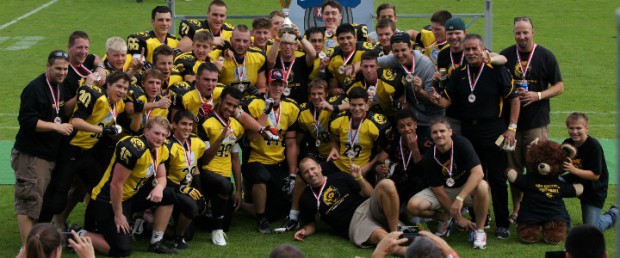
The Bern Grizzlies of the SAFV in Switzerland.
Translations of this article are also available in the following languages:EspañolFrançaisItalianoPortuguês
To say that it once seemed unlikely that American football could ever grow in Europe would be quite an understatement.
That’s not to say that it seemed unlikely because it was American in origin. Basketball has certainly taken hold in Europe along with baseball, volleyball, and lacrosse to a lesser extent, so the fact that American football was born elsewhere wasn’t a major contributing factor in this belief. There were other, more substantiated concerns that should have prevented the growth of the sport.
The first element that posed a challenge for the game in Europe is the sheer size of a team that is required to play American football. To function at its most efficient level, an American football team typically needs a roster of at least 45 players. This is due to the number of players needed on the field at one time (11), the specialization of the game (several different positions requiring various skill sets), and the depth necessary to confront the risk of injury. With a team this large and complex, it requires an entire coaching staff to coach each position, as opposed to teams in other sports such as soccer and basketball that can be run by a single coach. Along with the necessity of a large coaching staff also comes the need to train these coaches, not to mention referees.
Next, we have the challenge of accessing American football equipment, which is typically manufactured in North America. Due to the equipment being manufactured on another continent, accessing it is not convenient in every country and we are forced to pay a premium for it when we do. This includes not only football pads, helmets, and cleats, but also blocking shields and sleds, gameday field equipment, and so on.
Since few American football-specific fields exist in Europe, most teams need to compete with local soccer and rugby clubs for the use of their fields. Understandably, many teams and communities are protective of their fields due to scheduling concerns. Unfortunately these same teams and communities may also hold unfounded beliefs about excessive damage that American football teams can do to the field.
All of these factors threatened the growth of American football in Europe. Yet here we are.
In spite of all of the challenges that could have impeded this growth, Europe now boasts over 1,500 senior-level American football teams across 35 countries. Throw in approximately 700 junior teams, over 200 women’s teams, and countless flag football teams. American football has not only survived, it has thrived.
Although there have been speed bumps and setbacks, there are countless advantages that American football has in its favor.
The appeal of American football is profound. It is the ultimate team sport, it’s incredibly strategic in nature, and offers unparalleled intensity. There is a position for everyone and it teaches players some very important values such as toughness, teamwork, commitment, unity, and strength. Players and coaches also form a strong bond as they work together to achieve a common goal.
The advancement of technology has also played a major factor in this progress. National Football League games were first broadcasted in Europe starting in the 70’s and 80’s, spurring an initial interest in the game. Video games such as Madden NFL and NCAA Football 2K built additional interest and familiarized European fans with the strategy of the game as well as players from each of these leagues. Additionally, more sports bars in Europe broadcast NFL and NCAA football games than ever before. Today, fans can watch American football games from anywhere with the help of streaming services such as NFL Game Pass and NCAA College Pass. The best American football in the world has never been more accessible.
Europe was not restricted to televised versions of the game, either. NFL Europe gave European fans their first taste of live professional American football from 1991-2007, building a loyal following in the process. The NFL International Series in London, which came about in 2007, has been a major breakthrough for the NFL in its long-term goal to establish the league’s first franchise there. Fans have streamed in from all over Europe for the games and the series has created a lot of exposure for American football in the U.K. as well as the rest of the European continent. Both NFL Europe and the NFL International Series brought live games at a high level and along with it the experience of attending an NFL game, which provides a unique atmosphere that is unrivaled in Europe.
Nowadays, European teams have expanded to play consistently against international competition. Coaches and referees have the opportunity to attend clinics to improve their knowledge and performance on the field. Players can attend camps and play against some of the best import players the world has to offer. American football shops have innovated and found ways to import equipment from North America, making it easier to play the game than ever before. Fans are now enjoying a better experience every year as teams are fine-tuning their gameday experience to ensure that they keep coming back. More teams and players increase the prevalence of the game and create further public awareness for the sport. Overall, advocates of American football in Europe are becoming more and more interconnected, which improves the sharing of knowledge and information, benefiting all those involved. This development has been truly astounding.
American football grew in Europe despite all the odds, which speaks to how great the game is. The game is so great that people with minimum to no experience took the leap of starting teams in their respective cities. The story has been duplicated so many times before: a group of fans start throwing a football around, which turns into a team, and ultimately a league. Within just a few years, their country goes from having zero American football teams to boasting 2-3 divisions and even regional leagues. It’s inspiring to see this rapid growth, and the rise of the sport is at an exponential stage.
Since 2000, we’ve grown from approximately 400 teams across Europe to over 1,500. Step by step, we’re building a bright future for American football in Europe and the sky is truly the limit.
If we can overcome these challenges, we can overcome anything. Stay positive and keep pushing forward. We’re all in this together.








